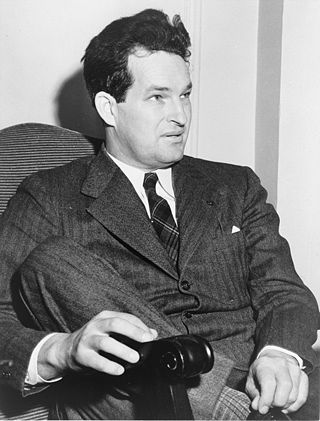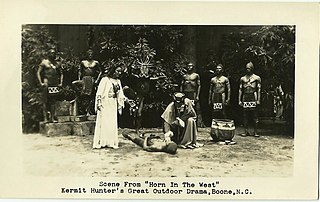
Kermit Houston Hunter was an American playwright known primarily for writing historical outdoor dramas. His many works include two dramas for Cherokee tribes, one for the Eastern Band of Cherokee Indians in North Carolina and one written for the larger Cherokee Nation of Oklahoma.

The Catawba, also known as Issa, Essa or Iswä but most commonly Iswa, are a federally recognized tribe of Native Americans, known as the Catawba Indian Nation. Their current lands are in South Carolina, on the Catawba River, near the city of Rock Hill. Their territory once extended into North Carolina, as well, and they still have legal claim to some parcels of land in that state. They were once considered one of the most powerful Southeastern tribes in the Carolina Piedmont, as well as one of the most powerful tribes in the South as a whole, with other, smaller tribes merging into the Catawba as their post-contact numbers dwindled due to the effects of colonization on the region.

Cherokee is a census-designated place (CDP) in Swain and Jackson counties in Western North Carolina, United States, within the Qualla Boundary land trust. Cherokee is located in the Oconaluftee River Valley around the intersection of U.S. Routes 19 and 441. As of the 2020 census, the CDP had a population of 2,195. It is the capital of the federally recognized Eastern Band of Cherokee Indians, one of three recognized Cherokee tribes and the only one in North Carolina.

The Qualla Boundary or The Qualla is territory held as a land trust by the United States government for the federally recognized Eastern Band of Cherokee Indians, who reside in western North Carolina. The area is part of the large historic Cherokee territory in the Southeast, which extended into eastern Tennessee, western South Carolina, northern Georgia and Alabama. Currently, the largest contiguous portion of the Qualla lies in Haywood, Swain, and Jackson counties and is centered on the community of Cherokee, which serves as the tribal capital of the Eastern Band of Cherokee Indians. Smaller, discontiguous parcels also lie in Graham and Cherokee counties, near the communities of Snowbird and Murphy respectively.
The Eastern Band of Cherokee Indians (EBCI), is a federally recognized Indian Tribe based in Western North Carolina in the United States. They are descended from the small group of 800–1000 Cherokee who remained in the Eastern United States after the US military, under the Indian Removal Act, moved the other 15,000 Cherokee to west of the Mississippi River in the late 1830s, to Indian Territory. Those Cherokee remaining in the East were to give up tribal Cherokee citizenship and to assimilate. They became US citizens.

Paul Eliot Green was an American playwright whose work includes historical dramas of life in North Carolina during the first decades of the twentieth century. He received the Pulitzer Prize for Drama for his 1927 play, In Abraham's Bosom, which was included in Burns Mantle's The Best Plays of 1926-1927.

Cherokee society is the culture and societal structures shared by the Cherokee Peoples. It can also mean the extended family or village. The Cherokee are Indigenous to the mountain and inland regions of the southeastern United States in the areas of present-day North Carolina, and historically in South Carolina, Tennessee, Virginia, and Georgia. The majority of the tribe was forcibly removed to Indian Territory in Oklahoma in the 1830s.

The Cherokee Heritage Center is a non-profit historical society and museum campus that seeks to preserve the historical and cultural artifacts, language, and traditional crafts of the Cherokee. The Heritage center also hosts the central genealogy database and genealogy research center for the Cherokee People. The Heritage Center is located on the site of the mid-19th century Cherokee Seminary building in Park Hill, Oklahoma, a suburb of Tahlequah, and was constructed near the old structure. It is a unit of the Cherokee National Historical Society and is sponsored by the Cherokee Nation, the United Keetoowah Band of Cherokee Indians, and other area tribes. The center was originally known as Tsa-La-Gi but is now known as the Cherokee Heritage Center.

Horn in the West, by Kermit Hunter, is an outdoor drama produced every summer since 1952 in the Daniel Boone Amphitheater in Boone, North Carolina. The show, the oldest revolutionary war drama in the United States, was about the life and times of the hardy mountain settlers of western North Carolina and eastern Tennessee. It covers a time period during the American Revolution between the Battle of Alamance in 1771 and the Battle of King's Mountain in 1780. The story follows the family of Dr. Geoffrey Stuart, a British loyalist, who is forced to flee the lower colony due to the actions of his son during the Battle of Alamance. Led into the mountain country by frontiersman Daniel Boone, Stuart must come to terms with his own loyalties, which are divided between his country and his son.
Joyce Dugan is an American educator, school administrator, and politician; she served as the 24th Principal Chief of the federally recognized Eastern Band of Cherokee Indians (1995-1999), based in Western North Carolina. She was the first woman to be elected to this office, and as of 2022 the only one.
The Lost Colony is an historical outdoor drama, written by American Paul Green and produced since 1937 in Manteo, North Carolina. It is based on accounts of Sir Walter Raleigh's attempts in the 16th century to establish a permanent settlement on Roanoke Island, then part of the Colony of Virginia. The play has been performed in an outdoor amphitheater located on the site of the original Roanoke Colony in the Outer Banks. More than four million people have seen it since 1937. It received a special Tony Honors for Excellence in Theatre award in 2013.
The Snow Camp Theatre is semi-professional theatre company in Snow Camp, an unincorporated community in southern Alamance County, North Carolina that brings the voices of the past into the hearts and minds of a modern audience from around the world by producing engaging historical dramas that inspire and entertain.
Tsali was a noted leader of the Cherokee during two different periods of the history of the tribe. As a young man, Tsali joined the Chickamauga faction of the Cherokee in the late 18th century, and became a leader in the fight against the American frontiersmen and their constant expansion into tribal lands. Later In 1812, he became known as The Prophet, and urged the Cherokee to ally with the Shawnee warrior, Tecumseh, in war against the Americans. Two decades later, in what seemed a fulfilment of his earlier prophecy, he resisted the forced removal of the Native Americans from their mountainous, western North Carolina towns, and as a result, a large following of like-minded Cherokee gathered to him. Following Tsali's martyrdom, the three hundred fugitive followers of his that remained free after his sacrifice became the forebearers of some 14,000 registered members of the Eastern Band of the Cherokee Indians living today in the Qualla Boundary.
The outdoor drama, also known as the symphonic outdoor drama or symphonic drama, is a kind of historical play, often featuring music and dance, staged in outdoor amphitheaters in the location it depicts.

Cherokee history is the written and oral lore, traditions, and historical record maintained by the living Cherokee people and their ancestors. In the 21st century, leaders of the Cherokee people define themselves as those persons enrolled in one of the three federally recognized Cherokee tribes: The Eastern Band of Cherokee Indians, The Cherokee Nation, and The United Keetoowah Band of Cherokee Indians.

Cherokee Preservation Foundation is an independent nonprofit foundation established in 2000 as part of the Tribal-State Compact amendment between the Eastern Band of Cherokee Indians (EBCI) and the State of North Carolina. The Foundation is funded by the EBCI from gaming revenues generated by the Tribe; it is not associated with any for-profit gaming entity and is a separately functioning organization independent of the Tribal government. It works to improve the quality of life of the EBCI and strengthen the western North Carolina region by balancing Cherokee ways with the pursuit of new opportunities.
Edward Louis Grady was an American stage, film and television actor and teacher.
The Eastern Band of Cherokee Indians educational policies have shaped the scholastic opportunities afforded to its members. The decision of the Eastern Band of Cherokee Indians (EBCI) to take control of the schools located on the Qualla Boundary under the Tribally Controlled Schools Act of 1987 started a wave of tribal responsibility in education. EBCI Tribal Council began producing programs that aided its members in most all aspects of the educational process. The evolution of these programs, their financing, and their relationship with tribal members and non-members alike are in a constant state of flux dependent upon policies produced by the EBCI tribal council. The EBCI tribal council does not directory set educational policy, although some if its members do set on boards that govern the educational facilities, and in most cases the director of the educational programs do report to the tribal council throughout the year. The policies of the EBCI educational programs can be analyzed through their respective goals, objectives, and procedures.

Too-Cowee, was an important historic Cherokee town located near the Little Tennessee River north of present-day Franklin, North Carolina. It also had a prehistoric platform mound and earlier village built by ancestral peoples. As their expression of public architecture, the Cherokee built a townhouse on top of the mound. It was the place for their community gatherings in their highly decentralized society. The name translates to "pig fat" in English. British traders and colonists referred to Cowee as one of the Cherokee Middle Towns along this river; they defined geographic groupings based in relation to their coastal settlements, such as Charlestown, South Carolina.

The historic Cherokee settlements were Cherokee settlements established in Southeastern North America up to the removals of the early 19th century. Several settlements had existed prior to and were initially contacted by explorers and colonists of the colonial powers as they made inroads into frontier areas. Others were established later.
















